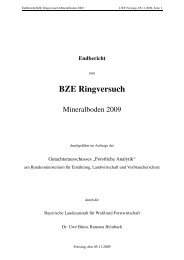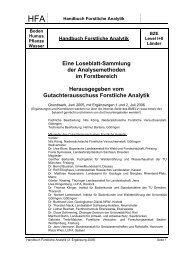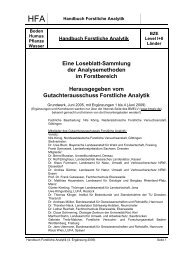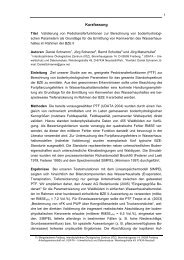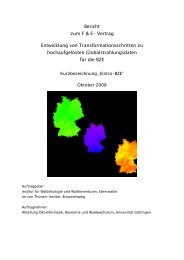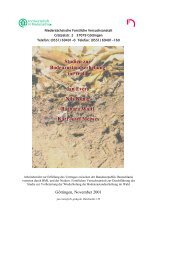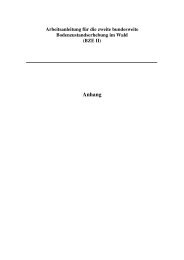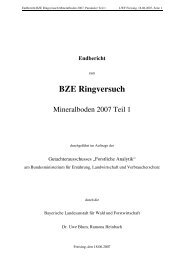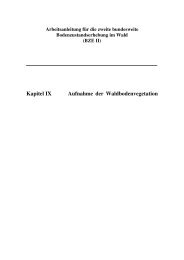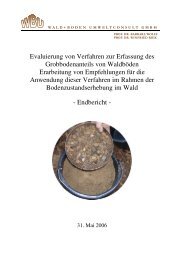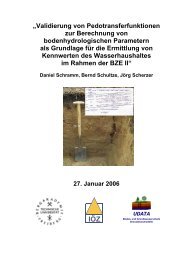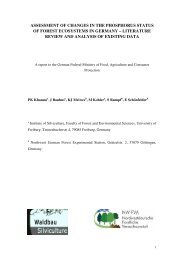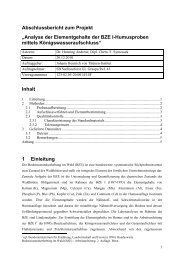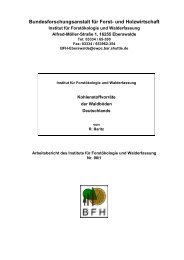assessment of changes in the phosphorus status of forest ...
assessment of changes in the phosphorus status of forest ...
assessment of changes in the phosphorus status of forest ...
You also want an ePaper? Increase the reach of your titles
YUMPU automatically turns print PDFs into web optimized ePapers that Google loves.
enhances <strong>the</strong> dissolution <strong>of</strong> Ca-phosphates. Moreover, this extract<strong>in</strong>g solution<br />
removes dissolved and adsorbed P on calcium carbonate and o<strong>the</strong>r surfaces (Al- and<br />
Fe-oxide). As expected, this method would extract a significant amount <strong>of</strong> organic<br />
matter and thus P associated with it. In recent years, this method has been <strong>in</strong>cluded <strong>in</strong><br />
<strong>the</strong> sequential extraction procedure, where both <strong>the</strong> <strong>in</strong>organic P and organic P forms<br />
extracted by this method are described as readily labile forms. There is very little<br />
evidence to show that <strong>the</strong> organic P fraction extracted by this reagent is readily<br />
m<strong>in</strong>eralisable and can be treated <strong>in</strong> <strong>the</strong> same category as <strong>the</strong> <strong>in</strong>organic P fraction. This<br />
method has been used to detect short-term <strong>changes</strong> <strong>in</strong> <strong>the</strong> amount <strong>of</strong> P <strong>in</strong> <strong>forest</strong> soils.<br />
For example, Bekunda et al. (1990) showed that <strong>changes</strong> <strong>in</strong> <strong>the</strong> amount <strong>of</strong> <strong>in</strong>organic P<br />
ow<strong>in</strong>g to different forms <strong>of</strong> slash management at <strong>the</strong> time <strong>of</strong> plantation establishment<br />
could be measured by <strong>the</strong> NaHCO3 method with good results, though not for organic<br />
P measured <strong>in</strong> <strong>the</strong> extract.<br />
Solutions conta<strong>in</strong><strong>in</strong>g lactate and citrate anions are also extensively used to release P <strong>in</strong><br />
soil test methods. These methods are based on <strong>the</strong> desorption and exchange <strong>of</strong> P from<br />
various soil components. In Germany, Scand<strong>in</strong>avia and many East European<br />
countries different versions <strong>of</strong> <strong>the</strong> lactate method which was suggested by Riehm<br />
(1947) are used. Of <strong>the</strong> two commonly used versions, CAL (calcium lactate and<br />
acetic acid at pH 3.5) dissolves less P than <strong>the</strong> DL (Double lactate) method. The<br />
method extracts comparatively low values <strong>of</strong> P from <strong>forest</strong> soils, when compared to<br />
soils from agricultural land uses, as can be been <strong>in</strong> <strong>the</strong> Fig 13 taken from Le<strong>in</strong>weber<br />
et al. ( 1993). Thus <strong>the</strong> usefulness <strong>of</strong> <strong>the</strong> method to detect small <strong>changes</strong> <strong>in</strong> P <strong>status</strong> <strong>of</strong><br />
<strong>forest</strong>s soils is highly questionable. This method may however be useful for assess<strong>in</strong>g<br />
short term <strong>changes</strong> <strong>in</strong> <strong>forest</strong> soils, eg., after fertilizer additions.<br />
Mehlich used a comb<strong>in</strong>ation <strong>of</strong> HCl and H2SO4 acids (Mehlich 1) to extract P from<br />
soils <strong>in</strong> <strong>the</strong> north-central region <strong>of</strong> <strong>the</strong> U.S. which he modified (Mehlich 1984) to<br />
develop a multi-element extractant. Mehlich 3 extractant is a comb<strong>in</strong>ation <strong>of</strong> acids<br />
(acetic and nitric), salts (ammonium fluoride and ammonium nitrate), and <strong>the</strong><br />
chelat<strong>in</strong>g agent (EDTA). This is a commonly used method, also for <strong>forest</strong> soils <strong>in</strong><br />
parts <strong>of</strong> USA. These methods as <strong>the</strong> o<strong>the</strong>r methods mentioned above provide useful<br />
results for specific short term <strong>changes</strong> <strong>in</strong> P <strong>status</strong>, but as shown by Richter et al.<br />
(2006) this method could not predict <strong>the</strong> long-term amount <strong>of</strong> P taken up by an<br />
aggrad<strong>in</strong>g p<strong>in</strong>e ecosystem.<br />
Use <strong>of</strong> anion exchange res<strong>in</strong> act<strong>in</strong>g as a s<strong>in</strong>k to extract P has been <strong>in</strong> use for a long<br />
time. In recent years an impregnated paper with anion exchange res<strong>in</strong> (Sharpley 2000)<br />
61



